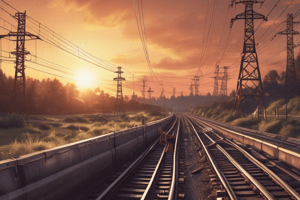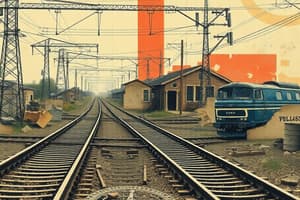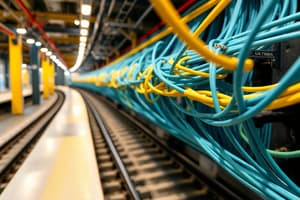Podcast
Questions and Answers
What factors should be considered when determining the number and type of cables for a route?
What factors should be considered when determining the number and type of cables for a route?
The type of circuits desired and the allocation of quad for the specific applications should be considered.
Why is it important to leave spare conductors in cable installations?
Why is it important to leave spare conductors in cable installations?
Leaving 25% or more conductors spare allows for future expansions due to the long codal life of these cables.
How should the route for laying cables be determined?
How should the route for laying cables be determined?
The route should be decided by traveling or walking along the track to identify the best alignment.
What should be included in the route plan for cable installation?
What should be included in the route plan for cable installation?
What is the recommended distance for laying telecom cables from the nearest track?
What is the recommended distance for laying telecom cables from the nearest track?
What precautions should be taken when laying cables during the monsoon season?
What precautions should be taken when laying cables during the monsoon season?
How frequently should cable markers be placed along the route?
How frequently should cable markers be placed along the route?
What are the specifications for cable markers along the quad cable route?
What are the specifications for cable markers along the quad cable route?
What color painting is used for easy identification of Quad joints?
What color painting is used for easy identification of Quad joints?
What is the minimum depth for laying the cable underground?
What is the minimum depth for laying the cable underground?
When can the distance to be maintained between the cable and the OHE mast be reduced to 0.5m?
When can the distance to be maintained between the cable and the OHE mast be reduced to 0.5m?
What is the required distance from the nearest edge of the cable trench to OHE masts if the trench exceeds 0.5m in depth?
What is the required distance from the nearest edge of the cable trench to OHE masts if the trench exceeds 0.5m in depth?
How far should the cable be laid from any metallic body of traction sub-stations?
How far should the cable be laid from any metallic body of traction sub-stations?
What distance must be maintained when laying cables near OHE switching stations from station earthing?
What distance must be maintained when laying cables near OHE switching stations from station earthing?
What is the standard distance from the center of the nearest track for laying cables outside station limits?
What is the standard distance from the center of the nearest track for laying cables outside station limits?
How much distance should be maintained between signalling and telecommunication cables laid in the same trench?
How much distance should be maintained between signalling and telecommunication cables laid in the same trench?
What is the minimum bending radius for aluminium sheathed armoured cables during laying?
What is the minimum bending radius for aluminium sheathed armoured cables during laying?
How should cables be laid across the railway tracks in relation to rail flanges?
How should cables be laid across the railway tracks in relation to rail flanges?
Why is it recommended to leave at least 25% spare conductors in cable installations?
Why is it recommended to leave at least 25% spare conductors in cable installations?
What key aspects should be marked on the route plan for cable installation?
What key aspects should be marked on the route plan for cable installation?
Describe the optimal distance for laying telecom cables from the track and within the railway boundary.
Describe the optimal distance for laying telecom cables from the track and within the railway boundary.
What protocols should be followed when making trenches near track formations?
What protocols should be followed when making trenches near track formations?
What is the significance of marking cable joints and important points along the cable route?
What is the significance of marking cable joints and important points along the cable route?
Under what conditions should special care be taken when laying cables in alluvial soil?
Under what conditions should special care be taken when laying cables in alluvial soil?
What are the required intervals for cable markers along the route?
What are the required intervals for cable markers along the route?
What color should the Quad cable RCC route markers be painted for visibility?
What color should the Quad cable RCC route markers be painted for visibility?
What are the specifications for maintaining distance between cables and OHE masts in exceptional cases?
What are the specifications for maintaining distance between cables and OHE masts in exceptional cases?
How should the cable joints be marked for identification during installation?
How should the cable joints be marked for identification during installation?
In what situations should cables be laid in concrete pipes or enclosed brick channels?
In what situations should cables be laid in concrete pipes or enclosed brick channels?
What is the prescribed depth for burying cables parallel to the railway tracks?
What is the prescribed depth for burying cables parallel to the railway tracks?
What requirements are there for the installation of HT and LT power cables with telecommunication cables?
What requirements are there for the installation of HT and LT power cables with telecommunication cables?
Describe the required distance when laying cables near traction sub-station earthing.
Describe the required distance when laying cables near traction sub-station earthing.
What is the significance of maintaining a distance of 10 meters from the nearest track when laying cables outside station limits?
What is the significance of maintaining a distance of 10 meters from the nearest track when laying cables outside station limits?
What is the recommended method for laying cables when crossing railway tracks?
What is the recommended method for laying cables when crossing railway tracks?
What is the minimum distance that should be maintained between signalling and telecommunication cables when laid in the same trench?
What is the minimum distance that should be maintained between signalling and telecommunication cables when laid in the same trench?
What guidelines should be followed for cable installation on girder bridges or rocky terrain?
What guidelines should be followed for cable installation on girder bridges or rocky terrain?
What is the preferred distance for telecom cables to be laid within the railway boundary?
What is the preferred distance for telecom cables to be laid within the railway boundary?
What should be done after trenches are made for cable laying?
What should be done after trenches are made for cable laying?
What is the minimum distance that telecom cables should be maintained from the nearest track?
What is the minimum distance that telecom cables should be maintained from the nearest track?
Why are cable markers important in the cable-laying process?
Why are cable markers important in the cable-laying process?
What precaution should be taken during the monsoon season when laying cables?
What precaution should be taken during the monsoon season when laying cables?
How frequently should cable markers be placed along the route?
How frequently should cable markers be placed along the route?
What should be included in the route plan for cable installation?
What should be included in the route plan for cable installation?
What color should the Quad cable RCC route markers be painted?
What color should the Quad cable RCC route markers be painted?
What minimum depth should telecom cables be laid below the ground surface?
What minimum depth should telecom cables be laid below the ground surface?
What is the requirement for the distance between cables and traction sub-station earthing?
What is the requirement for the distance between cables and traction sub-station earthing?
When can the distance from the OHE mast to the cable be reduced to 0.5m?
When can the distance from the OHE mast to the cable be reduced to 0.5m?
What should the bending radius for aluminum sheathed armoured cables not be less than?
What should the bending radius for aluminum sheathed armoured cables not be less than?
What is the recommended distance between signalling and telecommunication cables in the same trench?
What is the recommended distance between signalling and telecommunication cables in the same trench?
What color should be used for marking Quad joints on RCC cable markers?
What color should be used for marking Quad joints on RCC cable markers?
What distance should be maintained from the center of the nearest track for laying cables outside the station limits?
What distance should be maintained from the center of the nearest track for laying cables outside the station limits?
What is the minimum distance required from station earthing at OHE switching stations?
What is the minimum distance required from station earthing at OHE switching stations?
How deep should cables be laid when crossing railway tracks?
How deep should cables be laid when crossing railway tracks?
Flashcards are hidden until you start studying
Study Notes
Cable Planning
- First, determine the number, size, and type of conductors needed for the desired circuits.
- Zonal Railway may allocate quad on 6Q, including BPAC/IBS, etc.
- Leave at least 25% spare conductors for future expansions in cables with 5 or more pairs; these cables have a long lifespan.
- Determine the route by walking along the track and identifying the best alignment.
- Mark the route on a plan showing the track alignment, offsets from existing structures, and all crossings (roads, tracks, power cables, water/sewage mains).
- Include existing power cable routes on the plan.
- Identify convenient distribution points for connecting main cables to smaller distribution cables or emergency sockets.
- Lay telecom cables within 1 meter of the railway boundary, using boundary pillars as reference.
- Ensure cables are at least 2 meters away from the nearest track and beyond the embankment.
- Trenches near the track formation require consultation with P.Way staff and must be filled and rammed the same day.
- Use extra caution during monsoon season and in alluvial soil.
- Maintain a minimum 1-meter separation from electrical power cables.
- Install cable markers every 50 meters and at key locations, including joints, crossings, and bends.
- Use the RDSO/TCDO/COP-22(a) drawing for Quad cable RCC route markers; paint red as specified, and yellow for joint identification.
- Bury cables at least 1 meter below ground level to ensure trench cleaning and cable laying.
- Minimum distance between cable and OHE mast is 1 meter if trench depth is less than 0.5 meters. Use concrete pipes for cable when this distance is difficult to maintain.
- If trench depth exceeds 0.5 meters near OHE masts, the nearest edge of the trench should be at least 3 meters away from the mast.
- Mark cable joint positions on nearest OHE mast with approved legend.
Cable Laying near Substations and OHE Switching Stations
- Keep cables one meter away from metallic bodies and substation earthing and lay within concrete pipes or brick channels for 300 meters on each side of the substation. Ideally, lay cables opposite the substation side.
- Maintain one-meter distance from metallic bodies and five meters from station earthing in OHE switching stations. Reduce this distance to one meter when cables are laid in concrete piles.
- Lay cables at least one meter away from the independent earth of OHE structures.
General Cable Laying Guidelines
- Lay cables outside station limits generally at a standard distance of 10 meters from the center of the nearest track.
- Maintain a 100 mm distance between signaling and telecommunication cables in the same trench using bricks at 2-meter intervals.
- Do not lay HT and LT power cables with telecommunication cables in the same trench.
- Bury cables parallel to the track at a depth of 1 meter; those laid across the track must be one meter below the rail flanges.
- Separate telecommunication cable trenches from power cable trenches as much as possible.
- Lay cables on girder bridges, culverts, rocky terrain, etc. according to approved methods for each location.
- Avoid sharp bends in cables; bending radius should be at least 40 times the cable diameter for aluminum sheathed armored cables.
- Normally lay OFC and quad cables in the same trenches. Refer to Chapter XIII for drawings.
Cable Planning Considerations
- When planning cable routes, determine the number of conductors, their sizes, and the cable type (quad/PIJF) based on the circuit requirements.
- Consider assigning quad cables on the 6Q, including BPAC/IBS, as determined by the Zonal Railway.
- Aim to leave at least 25% of conductors spare for future expansions in cables with 5 or more conductor pairs due to their long lifespan.
- Choose the cable route by walking along the track to assess the best alignment.
- Clearly illustrate the chosen route on a route plan showing track alignment, offsets from permanent structures, and crossing points (roads, tracks, power cables, water/sewage lines, etc.).
- Identify convenient points for distribution (main cable to smaller distribution cables for subscriber cabling or emergency sockets).
- Telecom cables are normally laid within 1 meter of the railway boundary, referencing boundary pillars. Consult P.Way/works officials if no pillars are available and lay the cable at least 2 meters from the nearest track and beyond the embankment.
- When laying near the track formation, consult with P.Way staff and fill in trenches immediately after cabling. Be extra careful during the monsoon season and in alluvial soil.
- Maintain a minimum separation of 1 meter between telecom cables and electrical power cables.
- Use cable markers every 50 meters along the route, marking important features like cable joints, crossings, bends/curves, and power/water/sewage lines. Use the Quad cable RCC route marker (Drawing no. RDSO/TCDO/COP-22(a)) painted red and yellow (for joints).
- Bury cables at least 1 meter below ground level. Ensure the trench is wide enough for easy cleaning and cable laying.
- In yards or areas with restricted trench depth (0.5m), keep a minimum distance of 1 meter between cables and OHE masts or any structures in contact with high-tension conductors. In these conditions, consider laying cables in concrete pipes to reduce the distance to 0.5m.
- Maintain a 3-meter distance between the nearest edge of the cable trench and the OHE mast when the trench depth exceeds 0.5m.
- Mark the location of cable joints on the nearby OHE mast using an approved legend.
Cable Laying in Specific Areas
- Near traction substations, lay the cable at least 1 meter away from grounded metallic bodies and substation earthing. Use concrete pipes or brick channels for a 300m section on either side of the substation. Ideally, lay the cable on the side of the track opposite the substation.
- Near OHE switching stations, maintain a 1-meter distance from grounded metallic bodies and at least 5 meters from station earthing. Reduce this distance to 1 meter if cables are laid in concrete piles.
- Ensure at least a 1-meter distance between cables and independent earthing for OHE structures.
- Outside station limits, generally lay the cable at a standard distance of 10m from the center of the nearest track.
- When laying signaling and telecommunication cables in the same trench, maintain a 100 mm distance using bricks placed every 2 meters.
- Power cables (HT and LT) and telecommunication cables should not be laid in the same trench.
- Burry cables parallel to the track at a depth of 1.0m and those crossing tracks at 1 meter below the rail flanges.
- Keep telecommunication cable trenches as far as possible from power cable trenches.
- Follow approved methods for laying cables on girder bridges, over culverts, through culvert beds, over rocky terrain, etc.
- Avoid sharp bends during cable laying, with a minimum bending radius of 40 times the cable diameter for aluminum sheathed armored cables.
- Lay OFC and quad cables in the same trenches, following the drawings in chapter XIII.
Cabling Planning and Route Selection
- Determine the number and size of conductors, as well as the cable type (quad/PIJF) based on the type of circuits required.
- Leave 25% or more conductors spare in cables carrying 5 or more pairs for future expansions.
- Choose the best cable route by walking/traveling along the track and identifying the optimal alignment.
- Document the chosen route on a plan, showing the track alignment, offsets from permanent structures, and important crossings (roads, power cables, water and sewage mains, etc.).
- Identify convenient points for distributing cables (main cable to smaller distribution cables, emergency socket locations).
- Lay telecom cables within 1 meter of the railway boundary, referencing boundary pillars or consulting P.Way officials for guidance.
- Maintain a minimum 2-meter distance from the nearest track and beyond the embankment.
- Trenches within the track formation area should be made with P.Way staff approval and filled before sunset.
- Ensure a 1-meter separation from electrical power cables.
Cable Marking and Depth
- Place markers at intervals of 50 meters along the route.
- Mark important points (joints, water/sewage mains, power cables, crossings, bends/curves) with additional markers.
- Use Quad cable RCC route markers as per RDSO/TCDO/COP-22(a) drawing and paint them red.
- Identify Quad joints with yellow enameled painting on all sides of the RCC cable marker above ground.
- Bury cables at least 1 meter below the surface of the ground.
- Ensure trench width allows for easy cleaning and cable laying.
Cable Layout Near OHE and Structures
- Maintain a minimum distance of one meter between cables and OHE masts or other structures in yards, using concrete pipes if the depth is limited to 0.5 meters.
- Keep the nearest edge of the cable trench at least 3 meters away from OHE masts if the trench depth exceeds 0.5 meters.
- Mark cable joint positions on the nearest OHE mast with an approved legend.
Cabling near Substations and Earthing Systems
- Lay cables one meter away from metallic bodies and sub-station earthing in the vicinity of traction substations.
- Include concrete pipes or brick channels for 300 meters on either side of the substation.
- Preferably lay cables on the opposite side of the track from the substation.
- Maintain a one-meter distance from metallic bodies and five meters from station earthing near OHE switching stations.
- This distance can be reduced to one meter if cables are laid in concrete piles.
- Lay cables one meter away from independent earth for OHE structures.
General Cabling Practices
- Lay cables outside station limits at a standard distance of 10 meters from the center of the nearest track.
- When laying signalling and telecommunication cables in the same trench, keep them separated by 100 mm using bricks placed at 2-meter intervals.
- Avoid laying HT and LT power cables and telecommunication cables in the same trench.
- Bury cables parallel to the track at a depth of 1.0 meter, while those laid across the track must be one meter below rail flanges.
- Keep the trench for telecommunication cables as far away as possible from the trench for power cables.
- Follow approved methods for cable laying on girder bridges, culverts, rocky terrain, and similar locations.
- Avoid sharp bends in cables, ensuring a bending radius no less than 40 times the cable diameter for aluminium sheathed armored cables.
OFC and Quad Cable Laying
- Typically lay OFC and Quad cables in the same trench.
- Refer to Chapter XIII for drawings on OFC/quad cable laying.
Studying That Suits You
Use AI to generate personalized quizzes and flashcards to suit your learning preferences.




